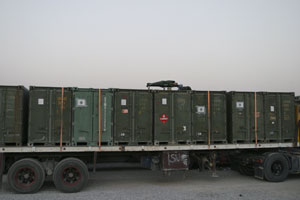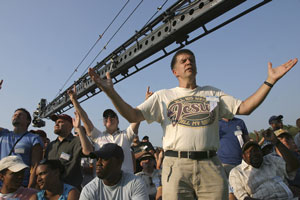 |
→ August 2005 Contents → Feature
|
From Golden Handcuffs to Stainless Steel Opportunities
|
 |
||||||||||||||||||
|
Over the past 10 years I have morphed, in fits and starts, consciously and unconsciously, from a well-paid newsmagazine photographer into a struggling, independent journalistic everyman. Along the way, I served as Beijing bureau chief for U.S. News & World Report, worked as a staff writer for Fortune, and did a two-year stint on air for CNN. It was an odd, exciting, frustrating, and profoundly nonlinear journey. But it was an essential and formative experience.
Independence is a bitch, financially and emotionally, and I have rough moments when I kick myself for leaving corporate comfort (rent day, for example). But I made the right choice. I have grown as a storyteller and journalist. I have linked up with other independents to brainstorm, collaborate, and to problem-solve. It's not quite a community yet, but we're getting there.
Technology -- the laptop, digital SLR, Photoshop, digital video cameras, Final Cut Pro, the satellite modem -- has made what we independents do easier, and it has added a certain polish to our work. But I began treading this path long before the digital revolution. I took a job at the Village Voice as a fact-checker in 1988 while slogging through photo grad school. I figured fact-checking would allow me to creep in the back door and into the Voice's legendary photo department. It didn't work out that way. They had their system, and I had to pay my dues with years of spec work and hustling before the editors took me seriously as a photographer.
I wrote my first book review after a little more than a year there. My editor, Polly Shulman, tackled my lumpy prose with stunning patience, line by line, as I sat next to her at a dilapidated computer terminal. I kept writing at the VV, then started pitching word-and-picture stories to the front-of-the-book editors. Around that time, I joined Impact Visuals, the photo agency/collective, and began eking out a living as a spot-news photographer and budding documentarian.
I got restless after nearly five years at the Voice and in New York City. Student loan bills from undergrad and grad studies were piling up, and I couldn't pay them with my sad little income. I didn't yet have the gumption -- or the focus -- to consider financing myself with credit cards. I knew I liked covering stories about regular people fighting the powerful, and I liked the rush of street protests and emergencies, but I didn't have a clear vision of what I wanted to create as a journalist.
I cast about for full-time work. Although I was having some success as a writer, I decided to move into photography more fully. Making pictures was more visceral and more satisfying to me than writing, particularly after two heady, talk-filled years as a photo grad student. Connections I made at the University of Missouri Photo Workshop got me over the transom with a few top newspaper and magazine photo editors. Mark Godfrey, U.S. News & World Report's Director of Photography, decided he liked the cut of my jib and signed me on as a staffer in 1993.
But so much of what I did in Washington, at the White House and on the Hill, felt like documenting political theater -- theater staged to spin and mollify the public rather than to inform. The best journalists in the White House press corps were the most patient. They endured the canned photo ops and the formulaic press releases, but they constantly probed for the meaning beneath the surface. The photographers and videographers kept their lenses trained on the action but always had their peripheral vision nailed to edge of the frame, lest something unscripted occur. I did okay, but I was not as disciplined. My restlessness, impatience, and, frankly, my anger, would catch up with me.
I would sit in the White House press briefing room and seethe as my colleagues engaged in rhetorical battle with Press Secretary Dee Dee Myers, and later Mike McCurry, over the latest statement by Newt or Jesse (Helms) about President Clinton. Conflict -- gotcha -- and spectacle were the running themes. (Thankfully, I left the White House press corps before the Lewinsky spectacle.)
I scribbled a quote in my journal from a New York Times piece that assessed Washington's media-political culture better than I could have at the time. "Washington has become the navel of an American news industry dominated by television," wrote Russell Baker in January 1996. "When the news deals extensively with a President's lack of television skills and the lack of same in an important politician like Bob Dole, what we have is a navel contemplating itself." Official Washington, and most of those covering it, was obsessed with the whorls of its own belly button. Still is.
As a sensitive, thinking human, I couldn't help but notice similarities between the ignored groups. These people were all economically and politically powerless. They were not of the same class or culture as the Washington mandarins. And, finally, though it's unfashionable to note such things these days, they were black.
I wanted to say more to readers, to people, as a journalist than I was saying with my photos. I wanted to shape stories rather than illustrate them. That meant writing. I put my name in the running for U.S. News' Beijing bureau chief slot. I was a long shot -- I had no track record as a writer for the magazine. To my credit, however, I had an undergraduate degree in East Asian Studies, plenty of China travel and study experience, and a grasp of Mandarin, though I wasn't fluent.
I landed the job with the support of a few influential U.S. News backers. I spent a few months on the foreign desk in D.C. before departing for China. I packed my cameras away, but I didn't fully retire them.
This was an historical time to be in China. I wrote about religion, migrant workers, the economy, political campaigns, crime. I covered Deng Xiaoping's death, and I was the only U.S. News writer in Hong Kong for the handover (photographers Jim LoScalzo and Torin Boyd busted their asses providing visual documentation of the week's events).
I served as bureau chief for roughly two years, until mid-1998, when U.S. News reorganized its China operation. Rather than return to Washington, I took another writing job at Fortune in New York City. I wanted to come home, all the way home.
At Fortune I worked with some stunningly talented editors, but I didn't take to the business-mag world. I wasn't trained in finance or economics, so I couldn't handle the deep investigative stories I felt were important. I also didn't have much of an interest in writing profiles of corporate titans.
My last major assignment for Fortune was to write a piece on the digital photography industry. These were heady days, 2000-2002. The first hookups between camera makers and online digital processors were happening. The activity in the sector was frenzied. The IPO bubble was still swollen, and it obscured the vision of even the most rational people.
I wasn't even shooting digital at this point. The technology still intimidated me, and since I was making a living pushing a pencil, I could still work with my Mamiya 6x7 and RDP on my own quiet little projects. But I was smart enough to realize that words, still photos, moving pictures, and sound were converging on the Web. I knew I needed to learn how to communicate, both online and in video, if I was to have a place in 21st-century newsgathering.
A CNN host trawling for new talent, Greta Van Susteren, called me and asked if I would be interested in applying for on-air work at the network. (Full disclosure: my sister was a producer on Greta's show at the time). I was offered a screen test, then a script-writing test. Producers and execs in Atlanta and New York vetted me in interviews. And then I was hired. In typical CNN hurry-up style, I had four days of training, under the broad and sure wings of former talent exec Bonnie Anderson, before being plugged into the on-air rotation.
I joined CNN as it was reinventing itself from a beige-but-reliable network where news was the star, as founder Ted Turner put it, into a flashier, more personality-driven enterprise that could compete with the televisually sexy Fox News Channel. Executives and programmers never quite hit on a successful formula, but they kept trying, which made us ground-level folks scramble.
I was assigned all manner of stories, from hard news to the positively squishy -- chase the Nor'easter across Pennsylvania and New York state; cover Mayor Giuliani's marital woes; go live at the premiere of the latest "Star Wars" movie. And then there were the stories with genuine gravity that I had the privilege to be assigned: the civil unrest in Cincinnati; 9-11; day-to-day events and the U.S. military's "Operation Anaconda" in Afghanistan.
It took me more than a year to become comfortable and fluid in front of the camera, particularly in live shots. By that time I think my bosses were tiring of me. I pushed back when pressed to do stories I thought were pointless, like Round Three of the Giuliani-Donna Hanover marital squabble. I could have shut up, paid my dues, and built myself into a commodity within the CNN brand, an entity with the power to green-light my own stories. I didn't think that was possible given the mismatch between my interests and concerns and the network's new market-oriented focus. I also didn't have the patience or the desire to pursue the change-from-within strategy.
I left CNN's offices for the last time and went straight to Cooper Union to hear a presentation by Arundhati Roy, author of The God of Small Things. Roy discussed her work fighting against the Indian government's Narmada dam project. She was passionate, fearless, factually prepared, and cogent. For me, Roy was a profound inspiration. She spoke truth to power in a way I felt the mainstream media weren't. That's what I needed to be doing.
Since leaving CNN in 2002 I have embarked on projects in Burma (now Myanmar, according to the ruling junta), Thailand, Japan, Iraq (embedded with the Marines), as well as here in N.Y.C. I have consulted for MTV, produced for the Tribeca Film Festival's documentation unit, shot stills for The New York Times and Politiken (Denmark), written for Newsweek International, Entertainment Weekly and Newsday. I am working on a digital doc based on my two-and-a-half months in Iskandariyah, Iraq.
And this is only the beginning.
© Brian Palmer
|
|||||||||||||||||||
Back to August 2005 Contents
|
|





